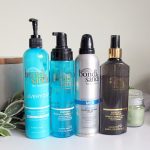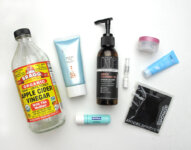The Science Vs podcast episode on Skin Care: Is Anti-Aging a Scam? in part inspired my recent post on whether retinol in cosmetic skincare products worked. I’ve had some questions about some of the other parts of the podcast, especially about vitamin C and whether it actually penetrates skin.
As I’ve discussed before, vitamin C in L-ascorbic acid form is one of the most evidence-supported skincare ingredients. This is a pretty uncontroversial opinion amongst scientists and doctors familiar with skincare science. So it’s understandably confusing when a science podcast says it can’t possibly work.
Science Vs do make some good points in the episode:
- The publicly-available evidence for skincare isn’t super robust, but a lot of that is explained by the regulatory and research landscape around cosmetics – as covered in my retinol post.
- Cosmetic companies do tend to stretch the truth in their marketing, and sometimes go beyond what’s scientifically defensible.
But there are a lot of claims that aren’t really backed by the evidence, including their own citations, particularly surrounding vitamin C and skin penetration.
Does Vitamin C penetrate skin?
The main claim in Chapter 3 of the podcast is that water soluble substances like L-ascorbic acid (vitamin C) can’t penetrate through skin:
So to get through – you need to be fat soluble. If you’re water soluble? Forget about it. And right there. A bunch of skin care products are already out of the game[25][26]. Like, one popular skin care ingredient… Vitamin C? You might read about how it’s a powerful antioxidant[27] … that sucks up stress in your skin… yeah, well —
SW It’s definitely water soluble.[28] Yes.
WZ And we need to be fat soluble to pass the barrier
SW Yes
WZ Then it’s not get – it’s not getting in??[29] Is that right?
SW Yes. Correct.
Even scientists at L’Oreal acknowledge that garden variety vitamin C can’t really penetrate your skin.[30]
Science Vs considerately provide a transcript of the episode that includes citations, which I really appreciate – they go above and beyond to paste the actual part from the source they’re relying on too. But unfortunately for this part, the references don’t support what they’re saying.
“Water-soluble substances can’t penetrate through skin” is a massive oversimplification. Most transdermal drugs are indeed lipophilic, but nicotine is very soluble in water and can be delivered through skin in patches and gels, for instance. It’s also contradicted by the specific part they cite from Reference 26‘s abstract:
For the very diverse group of chemicals considered, the results demonstrate that SC intercellular lipid properties alone are sufficient to account for the dependence of Kp upon MV (or MW) and Koct. It is found that the existence of an “aqueous-polar (pore) pathway” across the SC is not necessary to explain the Kp values of small, polar nonelectrolytes. Rather, their small size, and consequently high diffusivity, accounts for their apparently larger-than-expected Kp.
Translation: Whether substances can pass through skin depends on both polarity (related to water solubility) and molecular size. Small uncharged molecules can penetrate better than you would predict from their polarity, because they’re small.
So this suggests that L-ascorbic acid (a small, uncharged molecule) could potentially go through skin despite being water soluble.
References 25 and 26, put together, also give enough information to suggest that L-ascorbic acid could go through skin:
- Reference 26 presents an equation for estimating the permeability coefficient, log Kp, a measure of skin penetration. If you plug in the numbers for L-ascorbic acid, you get an estimated log Kp of -8.9.
- This isn’t very high, but Reference 25 does gives some measured permeability coefficients for several topical drugs so we can do a very-quick-and-dirty comparison (dark bar = without propylene glycol, dotted = with):
- L-ascorbic acid is in the same range as tacrolimus monohydrate, imiquimod, glycopyrrolate, clindamycin and tazorotene, which Reference 25 demonstrated would permeate more with propylene glycol. Many vitamin C products on the market are formulated with glycols and similar ingredients as penetration enhancers.
There are also lots of other studies which directly show that L-ascorbic acid penetrates skin. A bunch are listed in Reference 29… which Science Vs uses as their reference for LAA “not getting in”.
The statement they chose to cite is from the abstract of Reference 29:
…However, the instability of this water-soluble vitamin, together with difficulties associated with its topical delivery, has presented issues for the formulation chemist.
But the actual article elaborates on how formulation chemists have gotten around these “difficulties”:
Due to AA’s inherent hydrophilicity, penetration of AA across the skin might be expected to be poor. Nevertheless, significantly enhanced cutaneous levels of AA have been recorded after topical application.2–7 For optimal penetration of the epidermal barrier,6 aqueous formulations of AA (including its sodium salt) must be at a pH which is below the pKa of AA itself (pKa 4.2), thus reducing the charge density on the molecule. [Note: there are newer papers and patents from different authors that have reported ways of getting LAA into skin without necessarily having low pH.]
The instability and aqueous solubility of AA has historically presented issues for formulation. Nevertheless, the current understanding of AA now enables formulation for more than acceptable transdermal penetration.
Low pH or other penetration enhancement techniques are used in almost all ascorbic acid formulas.
Related post: Ultimate Vitamin C Skincare Guide Part 1: Ascorbic Acid
Their use of Reference 30 is similar – they use it to support the idea that “Even scientists at L’Oreal acknowledge that garden variety vitamin C can’t really penetrate your skin.”
The bit of the paper they cite:
vitamin C is a hydrophilic and unstable molecule with a low level of penetration into the skin.
“Low level of penetration” isn’t the same as “can’t really penetrate”, especially since ascorbic acid is often used at very high concentrations (up to 20%) in products to make up for low penetration. But there’s also what comes before and after that statement in the paper:
The formulation of a cosmeceutical product containing vitamin C is important to the product efficacy, as vitamin C is a hydrophilic and unstable molecule with a low level of penetration into the skin.7Reducing its acidity by decreasing the pH or using an instrumentation method, such as ultrasound, iontophoresis, or laser microdermabrasion, can enhance its penetration.9 [Note: this is actually one of the papers that found a way of getting ascorbic acid into skin at a higher pH.]
A bit later, Science Vs do say that there are exceptions:
To get around this fact that some ingredients are just waaaay too big penetrate into the skin, or are water soluble, researchers have tried to do things like use shrunken down molecules[39][40]… or put them in different suspensions, like fancy gels[41], that kinda makes them fat soluble… and Szu reckons it is possible that these souped-up chemicals miiight do something… [42][43] but the studies in this space don’t tend to be very good quality. Like, often they don’t even use placebo controls.[44][45][46]
And then even if you do manage to get some very special formulation of something – like say, let’s go back to Vitamin C? Well then, you run into other problems.
But vitamin C with low pH or other enhanced delivery systems aren’t “very special formulations”. They’re pretty darn common – I listed a whole bunch here (and that didn’t include the higher pH aqueous serums from L’Oreal and La Roche-Posay that I wasn’t aware of at the time!).
The “fancy gels”: Reference 41 is a 2002 paper describing an anhydrous polysilicone gel. Maybe they were fancy in 2002, but these days you can get ascorbic acid in anhydrous polysilicone gels from even super-budget-friendly brands like The Ordinary (they even have a more advanced version) and The Inkey List (note: these aren’t the best formulas for beginners, check out my vitamin C guide for better ones).
Similarly with “shrunken down” hyaluronic acid – lower molecular weight hyaluronic acid is very common in skincare products, and again, even The Ordinary and The Inkey List include it in their formulas.
(I did a chatty off-the-cuff video a while back talking about hyaluronic acid, and said it’s too big to get into skin – I somehow forgot the studies that showed that hyaluronic acid could actually get in and thicken skin, sorry! Serves me right for trying to be “casual”…)
I’ve discussed the quality of clinical trials issue in my retinol post – the same considerations apply here.
Related posts: Is Retinol a Scam? The Science
Stability and oxidation
The episode also discusses the problems with LAA instability, which are well known – I’ve talked about before.
And then even if you do manage to get some very special formulation of something – like say, let’s go back to Vitamin C? Well then, you run into other problems. Like, vitamin C is notoriously unstable. Those fancy serums that you get? They often come in glass bottles – but Vitamin C breaks down when it’s exposed to light, and that’s not all[47] …
One study, done by a skin care company, tried to put Vitamin C inside a hoity toity optimised emulsion to stop it from breaking down… and even then – after a month of living in a glass tube, exposed to some oxygen, about a third of the Vitamin C was gone.[48] A third.
There’s an implication that glass bottles can’t block light, but not all glass is clear, colourless window glass. Most products on the market use brown glass, or opaque packaging (usually painted glass or plastic).
The “hoity toity optimised emulsion” in Reference 48 is presented as an example of a formula with exemplary stability… but it isn’t. The authors actually explain that they used a O/W emulsion despite the fact this would decrease stability compared to W/O and anhydrous systems, because they wanted to optimise for consumer acceptance (a less thick and greasy product), and potentially increase delivery.
The study was also published 20 years ago, in 2004, and there’s no mention of the stabilization strategies mentioned in Reference 29, which are common in far less “hoity toity” formulas now:
exclusion of oxygen during formulation, oxygen-impermeable packaging, encapsulation, low pH, minimization of water, and inclusion of electrolytes and other antioxidants.
What happened?
So why did Science Vs get it wrong? I suspect it might be because of the relevance of the experts they consulted – this episode interviewed Dr Natalia Spierings, a UK dermatologist, and Dr Szu Wong, a lecturer in pharmaceutical science at Keele University.
As I’ve discussed before, cosmetic science is a bit of a niche topic that a lot of mainstream scientists consider frivolous and shallow, even though multinational cosmetic companies employ thousands of PhD-qualified scientists. The cosmetic industry also doesn’t make a lot of their research publicly available, so academic scientists often don’t realise it even exists. So while dermatologists and pharmaceutical scientists might seem like the right experts to ask, they don’t necessarily have relevant expertise unless they’ve gone out of their way to seek out information on skincare.
Dermatologists on social media can be very knowledgeable about skincare, but this isn’t representative of dermatologists in general. Some of my dermatologist friends have told me that they’ve been actively discouraged from learning about cosmetics. One dermatologist told me she was taught more about snakebite in her training than skincare. Many dermatologists have told me that they discovered my content because their patients were asking questions they couldn’t answer, so they had to look for answers on social media.
Dr Leslie Baumann was inspired to write her seminal textbook on cosmetic dermatology in 2002 because of the lack of information in traditional dermatology resources – many more dermatology textbooks now have chapters on cosmetic skincare products, but they’re still often riddled with mistakes (such as – you guessed it – the ubiquitous “physical sunscreens work like a shield” that’s still on the AAD website). But in general, most mainstream dermatology textbooks do say ascorbic acid works when it’s mentioned, including the popular Fitzpatrick and Bolognia dermatology textbooks. The top cosmetic dermatology textbooks from Baumann and Draelos also endorse the effectiveness of ascorbic acid.
Dr Spierings is quite well known on social media for her non-standard opinions on cosmetic products. I’ve talked about some misunderstandings about sunscreen that she’s promoted in the media before (e.g. the myth that chemical sunscreens need to be reapplied because they decompose with light exposure, while mineral sunscreens don’t need to be reapplied – not true, and conflicts with the regulated instructions on sunscreen packaging).
Related post: Sunscreen myths in the media
Skincare also isn’t really covered in mainstream pharmaceutical sciences. While many cosmetic scientists have a pharmaceutical science background, cosmetic skincare products aren’t pharmaceuticals, and skin is an excellent barrier (as mentioned in the podcast), making it an uncommon route of delivery for drugs. When it’s covered, the main focus is on transdermal drugs that absorb through skin into blood and have a systemic (whole-body) effect, rather than targeting the skin.
My undergraduate pharmacology textbook (Rang & Dale’s Pharmacology, 5th Edition, published 2003) only mentions tretinoin once, in the context of cancer treatment. Benzoyl peroxide, one of the first-line topical drugs for acne, isn’t mentioned at all. The latest edition (9th edn, 2020) does have a chapter on skin that goes into more detail on tretinoin, but benzoyl peroxide still isn’t mentioned, and topical salicylic acid (another popular, well-recognised and often recommended over-the-counter acne drug) is only mentioned for treating warts.
There are quite a lot of peer-reviewed articles on ascorbic acid though, including from researchers with no cosmetic industry affiliations. I suspect that if Dr Wong (not me, the other one!) had been given more time to prepare, the story might’ve turned out quite differently.
Citation padding
Again, I do really appreciate that they post a full transcript of their podcasts along with detailed citations – it’s something I try to do with my videos too.
But I did want to comment on citation padding, which is something I see a lot in beauty content, particularly from non-scientist influencers.
Citation padding is where sources that aren’t used are cited to make the reference list longer, so the content looks better-researched and more “sciencey”. But science isn’t a democracy – one really good paper can be more useful than 1000 dodgy ones. And often, citations don’t say what people claim they say.
Related post: Scientism or “Science-Washing” in Beauty
Some examples of citation padding here:
References 4-14 are all used to support the same basic concept: collagen and elastin are structural proteins in skin that become less organised and decline with age and UV. This really isn’t a concept that needs 11 references – Reference 5 (a review article) or Reference 8 (a whole textbook on skin aging) alone would’ve been enough.
References 15-18 and 20-25 are also all for a single basic concept: the stratum corneum is like a brick wall that acts as a barrier, and has a lipid “mortar” which many drugs pass through. Again, it’s really not something that needs 10 references.
There are some tweets from Science Vs that seem to indicate that they do want to present the number of citations as a marker of quality:

11 of the above 21 citations are also to the introductions of peer-reviewed papers. This goes against the whole rationale of citing peer-reviewed papers in the first place.
Introductions are just intended to set the background for the actual research. They don’t contain original findings, and are typically the least peer-reviewed part of a paper. Normal practice is to cite the original paper with the finding. If it’s a more generic and well-known concept (which these very much are), you’d usually cite a general review article (peer-reviewed, or from a reputable website) or textbook – those are usually more reliable sources, though they might not look as scientifically rigorous.
Related post: Why “peer reviewed” studies aren’t reliable (especially for beauty science)
References
Skin Care: Is Anti-Aging a Scam? (and transcript). Science Vs Podcast. May 18, 2023. Accessed November 22, 2023.
American Chemical Society. Molecule of the Week Archive: Nicotine. Published August 20, 2018. Accessed November 22, 2023.
Potts RO, Guy RH. Predicting skin permeability. Pharm Res. 1992;9(5):663-669. doi:10.1023/a:1015810312465
Carrer V, Alonso C, Pont M, et al. Effect of propylene glycol on the skin penetration of drugs. Arch Dermatol Res. 2020;312(5):337-352. doi:10.1007/s00403-019-02017-5
Stamford NP. Stability, transdermal penetration, and cutaneous effects of ascorbic acid and its derivatives. J Cosmet Dermatol. 2012;11(4):310-317. doi:10.1111/jocd.12006
De Dormael R, Bastien P, Sextius P, et al. Vitamin C Prevents Ultraviolet-induced Pigmentation in Healthy Volunteers: Bayesian Meta-analysis Results from 31 Randomized Controlled versus Vehicle Clinical Studies. J Clin Aesthet Dermatol. 2019;12(2):E53-E59.
Fitzpatrick RE, Rostan EF. Double-blind, half-face study comparing topical vitamin C and vehicle for rejuvenation of photodamage. Dermatol Surg. 2002;28(3):231-236. doi:10.1046/j.1524-4725.2002.01129.x
Raschke T, Koop U, Düsing HJ, et al. Topical activity of ascorbic acid: from in vitro optimization to in vivo efficacy. Skin Pharmacol Physiol. 2004;17(4):200-206. doi:10.1159/000078824
Zargaran D, Zoller F, Zargaran A, Weyrich T, Mosahebi A. Facial skin ageing: Key concepts and overview of processes. Int J Cosmet Sci. 2022;44(4):414-420. doi:10.1111/ics.12779
Gilchrest BA, Krutmann J, eds. Skin Aging, Springer; 2006.
Baumann LS, Rieder EA, Sun MD, eds. Baumann’s Cosmetic Dermatology. 3rd ed. McGraw Hill; 2022.
Kang S, Amagai M, Bruckner AL, Enk AH, Margolis DJ, McMichael AJ, Orringer JS. Fitzpatrick’s Dermatology. 9th ed. McGraw-Hill; 2019.
Bolognia JL, Schaffer JV, Cerroni L, eds. Dermatology. 4th ed. Elsevier; 2018.
Draelos ZD, ed. Cosmetic Dermatology: Products and Procedures. 3rd ed. John Wiley & Sons; 2022.
RAng HP, Dale MM, Ritter JM, Moore PK. Pharmacology. 5th ed. Elsevier; 2003.
Ritter JM, Flower R, Henderson G, Loke YK, MacEwan D, Rang HP. Rang and Dale’s Pharmacology. 9th ed. Elsevier; 2020.
American Academy of Dermatology. Acne clinical guideline. Published 2023. Accessed November 22, 2023.
This post contains affiliate links – if you decide to click through and support Lab Muffin financially (at no extra cost to you), thank you! For more information, see Disclosure Policy.









Wow, thanks Michelle for this great overview.
Thank you for explaining this so well.
Thank you for this. This same podcast did an episode on acne a while back and claimed there is no proof that salicylic acid helps acne, which I found this a bit dubious. I’d love to hear your thoughts!
Thank you for diving into this! I listened to the beginning of this podcast ages ago and was very confused given how often I’ve heard contrary advice. It’s extremely helpful to hear you clarify and correct their statements as needed.
From another scientist here (but PhD Physics) I fully appreciate what you have done with this article!
Aside from cosmetics, you also raise very valid points on the whole citation thing, my god!
Thanks for all the info and structured work you put into this!
Great stuff as always Michelle 🙂 Personally I’ve had some really positive results using products with a high Vitamin C concentration so reassuring to know it’s not all in my head! I do tend to keep the very high concentration products in a dark fridge to keep them in top condition longer.